 SOLVING TRIGONOMETRIC EQUATIONS
SOLVING TRIGONOMETRIC EQUATIONS SOLVING TRIGONOMETRIC EQUATIONS
SOLVING TRIGONOMETRIC EQUATIONS
Note:
If you would like an review of trigonometry, click on trigonometry.
Solve for x in the following equation.
Example 3:
There are an infinite number of solutions to this problem. To solve for x, you must first isolate the cosine term.
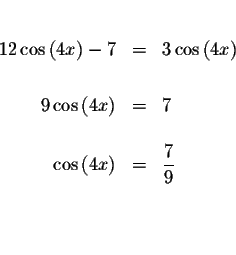
If we restriction the domain of the cosine function to
![$\left[ 0\leq 4x\leq
\pi \right] \rightarrow \left[ 0,\displaystyle \frac{\pi }{4}\right] $](img3.gif) ,
we can use the
inverse cosine function to solve for reference angle
,
we can use the
inverse cosine function to solve for reference angle
![]() and then
x.
and then
x.
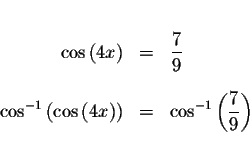
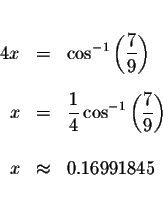
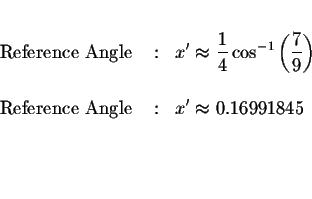
The period of
![]() is
is ![]() and the period of
and the period of
![]() is
is
 Divide the
interval
Divide the
interval
![$\left[ 0,\displaystyle \frac{\pi }{2}\right] $](img12.gif) into four equal intervals:
into four equal intervals:
![$
\left[ 0,\displaystyle \frac{\pi }{8}\right] ,$](img13.gif)
![$\left[ \displaystyle \frac{\pi }{8},\displaystyle \frac{\pi }{4}
\right] ,$](img14.gif)
![$\left[ \displaystyle \frac{\pi }{4},\displaystyle \frac{3\pi }{8}\right] ,$](img15.gif)
![$\left[ \displaystyle \frac{
3\pi }{8},\displaystyle \frac{\pi }{2}\right] .\bigskip $](img16.gif)
We know that the cosine function is positive in the first and the fourth
quadrant (intervals). Therefore two of the solutions are the angle
![]() that terminates in the first quadrant and the angle
that terminates in the first quadrant and the angle
 that terminates in the fourth quadrant.
We have already solved for
that terminates in the fourth quadrant.
We have already solved for
![]()
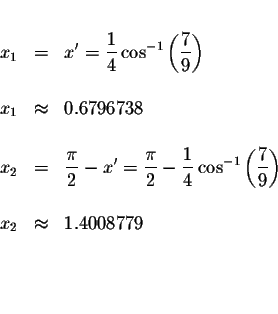
The solutions are
 and
and

The period of the
![]() function is
function is
![]() This means that the values will repeat every
This means that the values will repeat every
![]() radians in
both directions. Therefore, the exact solutions are
radians in
both directions. Therefore, the exact solutions are
 and
and
 where n is an integer.
where n is an integer.
The approximate solutions are
![]() and
and
![]() where n is an
integer.
where n is an
integer.
These solutions may or may not be the answers to the original problem. You much check them, either numerically or graphically, with the original equation.
Numerical Check:
Check answer x=0.16991845
Since the left side equals the right side when you substitute 0.16991845for x, then 0.16991845 is a solution.
Check answer
x=1.400878
Since the left side equals the right side when you substitute 1.400878 for x, then 1.400878 is a solution.
Graphical Check:
Graph the equation
Note that the graph crosses the x-axis many times indicating many solutions.
The graph crosses the x-axis at
0.16991845. Since the period is
 ,
it crosses again at
0.16991845+1.570796=1.74071477 and at
0.16991845+2(1.570796)=3.31151045,
etc.
,
it crosses again at
0.16991845+1.570796=1.74071477 and at
0.16991845+2(1.570796)=3.31151045,
etc.
The graph also crosses the x-axis at 1.400878. Since the period is
 ,
it crosses again at
1.400878+1.570796=2.971674and at
1.400878+2(1.570796)=4.5424707, etc.
,
it crosses again at
1.400878+1.570796=2.971674and at
1.400878+2(1.570796)=4.5424707, etc.
If you would like to test yourself by working some problems similar to this example, click on Problem.
IF you would like to go to the next section, click on Next.
If you would like to go back to the equation table of contents, click on Contents.
This site was built to accommodate the needs of students. The topics and problems are what students ask for. We ask students to help in the editing so that future viewers will access a cleaner site. If you feel that some of the material in this section is ambiguous or needs more clarification, please let us know by e-mail.

